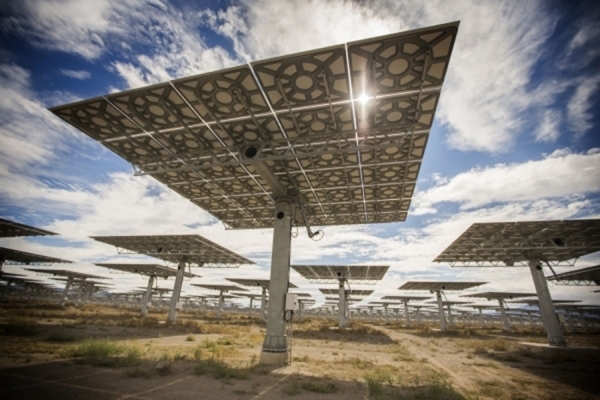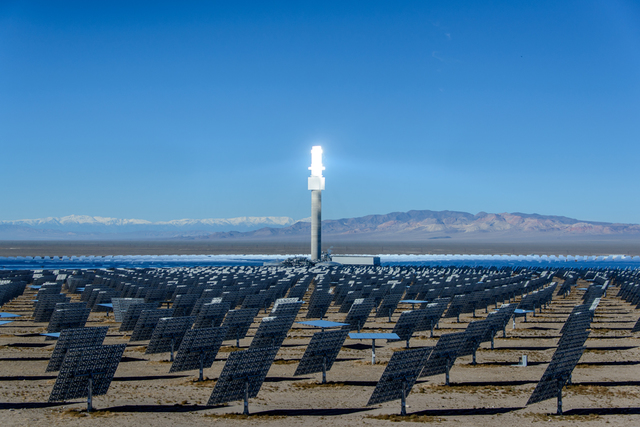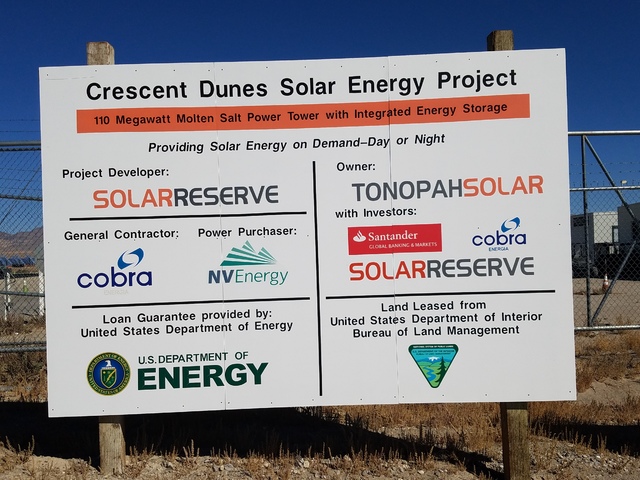Salt leak shuts down first-of-its-kind solar plant near Tonopah
A small leak in a tank filled with molten salt has shut down a $1 billion solar plant in Central Nevada touted for its ability to generate electricity day or night.
The Crescent Dunes Solar Energy Plant outside Tonopah, 225 miles northwest of Las Vegas, has been offline since late October and is expected to remain so until January.
The plant’s owner and operator, Santa Monica, California-based SolarReserve, played down the problem, which occurred less than a year after the facility began generating power.
“There really isn’t much of a story here,” company spokeswoman Mary Grikas said in an email Friday. “Dealing with issues such as these are typical in any newly constructed power plant project (or any new industrial project, for that matter).”
Crescent Dunes uses more than 10,000 mirrored heliostats, each with the square footage of a small house, to focus sunlight on a 640-foot-tall central tower and heat the molten salt inside to more than 1,000 degrees. The molten salt is then used to boil water, creating steam that drives generators to produce power day or night.
SolarReserve says its patented storage system can deliver electricity on demand like a traditional coal or natural gas power plant but with zero emissions, little water use and no hazardous waste.
The leak was discovered along a welded seam in the tank where the super heated salt is stored. There was no significant spill associated with the leak, just “a small amount of salt visible around the skirting of the … tank,” Grikas said.
She said the repairs are “not significant,” but they are time-consuming because the tank must first be drained and cooled down.
“Luckily, December is our month for scheduled plant maintenance, and we had planned a shutdown in December to prepare for 2017 operations,” Grikas said.
The 1,600-acre solar array built on public land over four years entered commercial operation in November 2015, when it began delivering electricity to NV Energy, its sole customer under a 25-year power-purchase agreement.
Grikas said Crescent Dunes has spent the past year gradually ramping up to its full, 500,000-megawatt-hours of annual power delivery, something that was expected to happen in January 2017. “We’re still on track for that,” she said.
The plant is the first of its kind in the world, and it took significantly longer to construct than company officials initially predicted. It was backed by $737 million in federal loan guarantees.
The small leak that shut the facility was discovered just days after SolarReserve CEO Kevin Smith, U.S. Sen. Dean Heller, R-Nev., and Deputy Energy Secretary Elizabeth Sherwood-Randall gathered at Crescent Dunes on Oct. 11 to unveil plans for as many as 10 more of the solar arrays in Nevada.
That $5 billion endeavor, known as project Sandstone, would rank as the world’s largest solar energy facility with an output of 1,500 to 2,000 megawatts. That’s enough to supply about a million homes, putting it on par with a nuclear power plant or the Hoover Dam.
SolarReserve has not announced exactly where it hopes to build the 16,000-acre project, but in October Smith said two potential sites, both on federal land in Nye County, had been identified.
Construction probably won’t start for another two or three years, Smith said. When it does, he said, the solar arrays and towers will be built one or two at a time, creating about 3,000 jobs over seven years or so.
David Jacobs from the Tonopah Times-Bonanza contributed to this report.
Contact Henry Brean at hbrean@reviewjournal.com or 702-383-0350. Follow @RefriedBrean on Twitter.






























